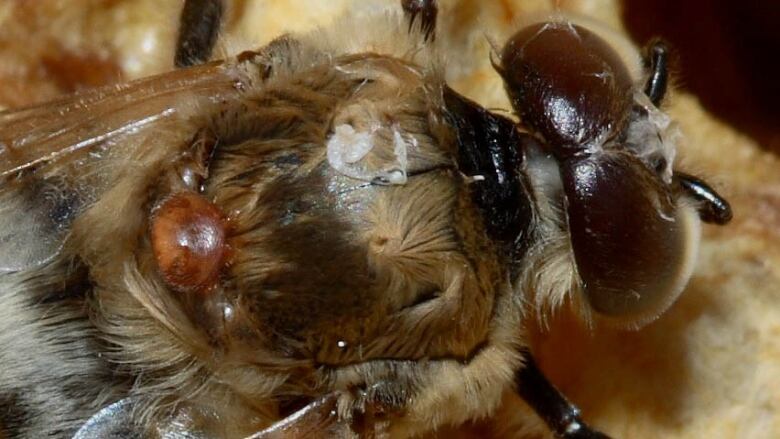Bee crisis: Are mites or neonics the real culprit?
Pesticide firms use tobacco tactics to sell products, beekeeper says
While pesticide companies and some researchers say the tiny Varroa mite is the main culprit in declining honeybee health, new Dutch research concludes that bees are more vulnerable to mites and other stressors because of their constant diet of neonicotinoid insecticides.
But the president of CropLife Canada, the association that promotes the use of neonicotinoids to control harmful insects on grains, fruits, vegetables and flowering plantsand for other uses, says the devastating effects of Varroa mites are the key to declining honeybee health.
"Have you ever seen a Varroa mite on a honeybee?" asks CropLife president Ted Menzies.

Now as Canada's voice for some of the biggest insecticide manufacturers in the world, such as Monsanto, Bayer, Syngenta and Dow, Menzies says he believes mites are a bigger threat than insecticides to bees.
"These are huge on a little tiny bee," says Menzies.
Some researchers agree.
Ernesto Guzman at the University of Guelph, Ontario's premier agricultural university,says theVarroa mite isthe main culprit. Guzman has told CBC he had "evidence that Varroa mites are problem No. 1 associated with bee mortality in southern Ontario."
Guzman admits, however, that his research has largely been on the mites and not on the pesticides.
The debate about what's killing honeybees and other pollinators has continued for several years, with Varroa mites largely taking the blame for colony collapse disorder.
But as more research is conducted,compiled and analyzed, researchers such as Henk Tennekes say there is no longer any doubt that the neurotoxic insecticides are the root cause of pollinator decline.

"When neonics are present, bees neglect to provide food for eggs and larvae, suffer from a breakdown of navigational abilities because of impaired cognitionand experience lower immunity, making them more susceptible to infectious diseases and parasitic opportunists such as Varroa mites," Tennekes wrote in a paper he delivered at Harvard earlier this year.
Ontario beekeepers tend to agree.
Last September, the law firm Siskinds LLP filed aclass action suiton behalf of severalOntario beekeepersfor $450 million against Syngenta and Bayer, two makers of the neonicotinoid insecticide that is used on 99 per cent of the corn and 66 per cent of the soybeans grown in Ontario.
The statement of claim alleges the pesticide companies were "negligent in their development and distribution of neonics."
The claim also alleges "the companies knew or ought to have known the insecticide would cause damage" to bee populations.
Andre Flys, abeekeeperfrom Nobleton, Ont., just north of Toronto, suggests the pesticide companies have been drawing attention to mites as a smokescreen while continuing to promote the safety and sale of their insecticides to farmers.
He compares the pesticide industry's focus on mites rather than neonicotinoids to the tobacco industry deflecting the health hazards caused by smoking.
"I compare it to the tobacco industry standing over a man who's been a smoker all of his life and has died of lung cancer and we start talking about what a health problem diabetes is," says Flys. Diabetes, like the Varroa mite, is a symptom of the real cause of death, he says.

"The Varroa mite is a real and proven threat to bee health, whereas the science is not substantiated that says that a reduction in the amount of [neonic]treated acres of corn and soybeans is going to solve what is a perceived problem," Menzies said at a consultation meeting earlier this year to discuss Ontario's proposal to restrict neonicotinoid use.
Health Canada's Pest Management Regulatory Agencysays Varroa mites are a known issue, whereas exposure to pesticides could affect bees "by unintentional exposure."
'A vampire cat'
Beekeeper Jim Coneybeare of Fergus, Ont., doesn't disagree with CropLife or Health Canada when it comes to the potential destructive power of mites on bees. He uses a metaphor similar to the jackrabbit comparison suggested by Menzies.
"Size-wise," says Coneybeare, "a Varroa can be similar to a vampire cat on a human sucking our blood if they are not controlled,"he says.
But, Coneybeare adds, "when we do experience a pesticide incident and Health Canada and Ontario's Agriculture and Food Ministry send out specialists to check Varroa levels in the hives, they're finding virtually no or very low numbers of Varroas, generally below a treatable level."
And yet, says Coneybeare, his bees are dying in record numbers.
Tennekesisone of several researchers to equate the current environmental issues surrounding neonics with those caused by DDT more than a half century ago.
Targeting neonics
His self-published book, The Systemic Insecticides: A Disaster in the Making, was one of the first to target neonics as the cause of the global pollinator decline.
Menzies countered Tennekes's conclusions when he said thaton a visit to Australia last year, he found bee colony losses were "greatly reduced" in areas with "minimal pressure of Varroa mites."
But Coneybeare says, "It's very difficult to control the greater environment when these neonics are there."
Besides, headds, "Varroa can only reproduce in a honeybee colony and therefore cannot account for the decline in wild pollinators and other insects and birds."
Tennekes, who also attributes songbird die-offs to neonics, recently told CBC News, "Soon the swallows will be gone forever."
"People don't see the urgency of the problem,"he says.
Health Canada says it will continue to review the research on the use of neonicotinoid pesticides "in co-operation with stakeholders."
"If warranted," itsays, "regulatory action will be taken at any time during the process to further protect bees."
Corrections
- A previous version of this story stated that the Ontario Beekeepers' Association (OBA) filed a class action lawsuit for $450 million against Syngenta and Bayer, two makers of the neonicotinoid insecticide that is used on 99 per cent of the corn and 66 per cent of the soybeans grown in Ontario. The class action was actually initiated by the law firm Siskinds LLP on behalf of several Ontario beekeepers. The OBA is neither the plaintiff nor the originator in this action. The error has been corrected in the story.Aug 10, 2015 10:41 AM ET













_(720p).jpg)


 OFFICIAL HD MUSIC VIDEO.jpg)
.jpg)



























































































